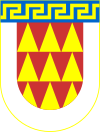| Massacre of the Albanian beys | |
|---|---|
| Location | Manastir, Ottoman Empire |
| Date | 9 August 1830 |
| Target | Albanian beys |
| Attack type | Mass murder |
| Deaths | 1000 Albanian beys and personal guards |
| Perpetrators | Ottoman forces |
The Massacre of the Albanian beys occurred on 9 August 1830, when around 500 Albanian leaders (beys) and their personal guards were killed by Ottoman forces in the town of Manastir (present-day Bitola, North Macedonia). The massacre led to the weakening of the power of the beys of southern Albania and also set the basis for the destruction of the powerful northern Albanian Pashalik of Scutari.
Background events
During the era of the Albanian Pashaliks, the influence of the local Albanian beys had weakened since they had lost the Pashalik of Yanina. In the late 1820s after the Greek War of Independence the Albanian mercenaries, who were employed by the Ottomans during the struggles, pillaged a large number of villages, while the bey families tried to restore and regain their rule. Their efforts included the organization of the assembly of Berat in December 1828, led by Ismail bey Qemali of the Vlora family, grandfather of Ismail Qemali, founder of the modern Albanian state in 1912. In this Convention, the leaders were Qemali, Zylyftar Poda and Shahin bej Delvina. The Ottoman Empire tried to prevent the rise of local beys, which presented a menace to centralized power. The bey also resented the modernization programs implemented during the reign of Mahmud II. These reforms were a direct threat to the arbitrary power of the Balkan Muslim aristocracy, who had grown powerful during the long decline of Ottoman power. On January 5, 1829, only one month after the Convention of Berat, its leader, Ismail bey Qemali, was killed in Yanina by people of Reşid Mehmed Pasha, which caused an upheaval in Southern Albania: in Yanina, Zagoria, Konitsa and Metsovo the Ottoman functionaries were asked to leave by the local population. The Sultan was forced to remove Reşid Mehmed Pasha and to nominate him Grand Vizir on 6 February 1829. In 1830, the Sublime Porte sent an expeditionary force under the command of Reşid Mehmed Pasha to suppress the local Albanian beys. On hearing the news of the Ottoman forces' arrival, the three most powerful local chiefs, Zylyftar Poda, accompanied by the remains of Ali Pasha's faction, Veli Bey (whose power base was around Yannina), and Arslan Bey, along with other less powerful beys, began to prepare their forces to resist a probable Ottoman attack.
Massacre
Realising the seriousness of the situation and the danger of a general uprising, Reşid Mehmed Pasha invited the Albanian beys to a meeting on the pretext that they would be rewarded for their loyalty to the Porte. Two of the main leaders, Veli and Arslan Bey, accepted the invitation and went together with their followers to meet with Reşid Mehmed Pasha at his headquarters in Monastir. On their arrival there, the commander led them into an enclosed field when they saw armed forces aligned in ceremonial salute parade. In fact, this was an ambush, and upon a sign from the pasha, the soldiers opened fire on the surprised Albanian beys and their personal guards. All the Albanians who had entered the field, some four to five hundred, were killed, while Arslan tried in vain to escape. He was killed by Ottoman forces after a short pursuit.
Aftermath
The massacre of the Albanian beys was a strong blow to the beys' power in Albania. In addition, the Ottomans, after having managed to deprive southern Albania from its leaders, defeated the following year, in 1831, the Pashalik of Scutari, the last remaining Albanian pashalik giving signals of separatism. Albanians would lose track with that particular period which led to the creation of new neighboring Balkan states. The population was not allowed to carry arms anymore, even the Muslims. The ruling cast throughout the Albanian Vilayets would be substituted with a more fanatic leadership, which would have a strong negative impact during the Albanian National Awakening later. Albanian credibility within the Empire would never recover completely.
Nevertheless, this did not end the opposition of the Albanians to the Ottoman regime, which re-emerged with the revolts of 1833-9 and that 1847.
In literature
The Monastir massacre of 1830 is the main theme of the novel Komisioni i festës (English: "The Celebration Commission") by Albanian writer Ismail Kadare. In Kadare's vision, this battle is the battle of two empires: the Albanian Kanun with its code of besa ("honor"), against the Ottoman Empire itself.
References
- "Masakra e Manastirit (9 gusht 1830)". Retrieved 5 October 2017.
- "Masakra e Manastirit: Kur otomanët vetëm në një ditë vranë 1000 shqiptarë - Telegrafi". 9 August 2016. Retrieved 5 October 2017.
- "- Bota Sot". Retrieved 5 October 2017.
- ^ Vickers 1999, p. 24.
- ^ Tozer 2009, pp. 167–169.
- "Dritan Egro on Panorama Zbulohet dokumenti, Pavarësia u kërkua që në vitin 1828". Archived from the original on 2 May 2012. Retrieved 5 October 2017.
- Kadare, Ismail (1980). Komisioni i festës. Prishtinë: Rilindja.
- ^ Colafato 1998, p. 82.
Sources
- Vickers, Miranda (1999). The Albanians: A Modern History. I.B. Tauris. ISBN 1-86064-541-0.
- Tozer, Henry Fanshawe (2009). Researches in the Highlands of Turkey Including Visits to Mounts Ida Athos Olympus and Pelion. BiblioBazaar. ISBN 978-1-115-99203-9.
- Colafato, Michele (1998). Emozioni e confini: per una sociologia delle relazioni etniche. Meltemi Editore srl. ISBN 88-86479-69-7.
| Geography |  | |
|---|---|---|
| History | ||
| Landmarks |
| |
| Sports | ||
| Education | ||
| Events | ||
| Transportation | ||
| People | ||
Categories:
